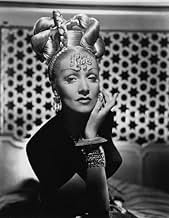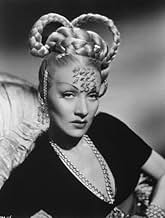VALUTAZIONE IMDb
6,0/10
1379
LA TUA VALUTAZIONE
Aggiungi una trama nella tua linguaIn ancient Baghdad, Hafiz the King of Beggars dreams of untold riches and of marrying his daughter to a real prince.In ancient Baghdad, Hafiz the King of Beggars dreams of untold riches and of marrying his daughter to a real prince.In ancient Baghdad, Hafiz the King of Beggars dreams of untold riches and of marrying his daughter to a real prince.
- Regia
- Sceneggiatura
- Star
- Candidato a 4 Oscar
- 1 vittoria e 4 candidature totali
Eddie Abdo
- Aide to Mansur
- (non citato nei titoli originali)
- …
Jimmy Ames
- Major Domo
- (non citato nei titoli originali)
Morris Ankrum
- The Caliph's Messenger
- (non citato nei titoli originali)
Leslie Anthony
- Handmaiden
- (non citato nei titoli originali)
Lynn Arlen
- Handmaiden
- (non citato nei titoli originali)
Noble Blake
- Nubian Slave
- (non citato nei titoli originali)
Carla Boehm
- Handmaiden
- (non citato nei titoli originali)
Dick Botiller
- Aide to Mansur
- (non citato nei titoli originali)
Recensioni in evidenza
Had Harold Arlen and E.Y. Harburg written anything memorable from this version of Kismet, Robert Wright and Chet Forrest might not have ever adapted Alexander Borodin's music to make their acclaimed version of Kismet in the fifties. We should all be the poorer for that.
Music is the weak spot in this version of Kismet, the songs sung by Joy Page and Marlene Dietrich aren't anything memorable. But classical American actor Otis Skinner who created the role of Hajj on Broadway back in 1911 is replaced by probably the only man in Hollywood who could have made that Edwardian dialog palatable to modern ears. Of course that would be Ronald Colman, a man I could get joy listening to him recite Buffalo Phone Directory.
This was one of MGM's biggest productions in the Forties, they splurged for technicolor and if you're going to have Marlene Dietrich play the seductive princess go for the gold. Lots of delightful cries emerged from cinema audiences when those golden painted legs of Dietrich were shown. Even on television they're still quite a sight.
Unfortunately the sound version of Kismet that Otis Skinner made in 1930 for Warner Brothers appears to be a lost film so we can't compare his interpretation of the lead with Colman. But in watching Colman's performance it seemed to be his Francois Villon aged so that he now had a teenage daughter. Anyway, it works beautifully.
James Craig is the earnest young caliph who I kept expecting to sing A Stranger in Paradise and Edward Arnold is the villainous vizier. Mr. Arnold played him like the political boss of ancient Bagdad.
MGM also filmed the better known musical version of Kismet with Howard Keel, Ann Blyth, and Vic Damone putting their marvelous voices to that classical score. That version has the music no doubt, but this one has Colman and Dietrich, so take your choice and you can't go wrong with either.
Music is the weak spot in this version of Kismet, the songs sung by Joy Page and Marlene Dietrich aren't anything memorable. But classical American actor Otis Skinner who created the role of Hajj on Broadway back in 1911 is replaced by probably the only man in Hollywood who could have made that Edwardian dialog palatable to modern ears. Of course that would be Ronald Colman, a man I could get joy listening to him recite Buffalo Phone Directory.
This was one of MGM's biggest productions in the Forties, they splurged for technicolor and if you're going to have Marlene Dietrich play the seductive princess go for the gold. Lots of delightful cries emerged from cinema audiences when those golden painted legs of Dietrich were shown. Even on television they're still quite a sight.
Unfortunately the sound version of Kismet that Otis Skinner made in 1930 for Warner Brothers appears to be a lost film so we can't compare his interpretation of the lead with Colman. But in watching Colman's performance it seemed to be his Francois Villon aged so that he now had a teenage daughter. Anyway, it works beautifully.
James Craig is the earnest young caliph who I kept expecting to sing A Stranger in Paradise and Edward Arnold is the villainous vizier. Mr. Arnold played him like the political boss of ancient Bagdad.
MGM also filmed the better known musical version of Kismet with Howard Keel, Ann Blyth, and Vic Damone putting their marvelous voices to that classical score. That version has the music no doubt, but this one has Colman and Dietrich, so take your choice and you can't go wrong with either.
I've always felt that the technicolor used in the 1940s constituted some of the best color photography ever seen on film. KISMET is no exception. The color is ravishing, with pastel hues for the sets and costumes in interior scenes and ranks with the best color cinematography of any of the '40s films.
Unfortunately, the vehicle itself is weak and Ronald Colman is not the most suitable choice for the role of the scheming beggar. I admire Colman and he uses his speaking voice to marvelous effect but it's hard to see any chemistry between him and Marlene Dietrich, nor does he seem agile enough in the role. She plays the seductive charmer with all of the glamour she is noted for, including a sensuous dance with her famous gams painted gold. Too bad she wasn't given more screen time since hers is the film's most interesting performance.
James Craig had some decent roles in the '40s but here he is totally bland and colorless as the prince that Colman's daughter is in love with--only she knows him as a common gardener. The improbable plot is a thin one but made bearable by the exquisite photography, busy musical background score and some good character actors. Edward Arnold has a major villainous supporting role and seems to be thoroughly enjoying himself.
In my opinion, the '55 musical remake with Howard Keel in the Colman part showed us just how good the role of the beggar could have been if Colman played it more tongue-in-cheek. Keel was more physically right for the role, as well. Unfortunately, Colman always looked on the verge of middle-age in most of his roles, no matter how early the films were!
Trivia: this KISMET was nominated for four Academy Awards: color cinematography, art direction, background score and sound recording. If the Best Costume category had been recognized then, it no doubt would have been nominated in that category too.
Unfortunately, the vehicle itself is weak and Ronald Colman is not the most suitable choice for the role of the scheming beggar. I admire Colman and he uses his speaking voice to marvelous effect but it's hard to see any chemistry between him and Marlene Dietrich, nor does he seem agile enough in the role. She plays the seductive charmer with all of the glamour she is noted for, including a sensuous dance with her famous gams painted gold. Too bad she wasn't given more screen time since hers is the film's most interesting performance.
James Craig had some decent roles in the '40s but here he is totally bland and colorless as the prince that Colman's daughter is in love with--only she knows him as a common gardener. The improbable plot is a thin one but made bearable by the exquisite photography, busy musical background score and some good character actors. Edward Arnold has a major villainous supporting role and seems to be thoroughly enjoying himself.
In my opinion, the '55 musical remake with Howard Keel in the Colman part showed us just how good the role of the beggar could have been if Colman played it more tongue-in-cheek. Keel was more physically right for the role, as well. Unfortunately, Colman always looked on the verge of middle-age in most of his roles, no matter how early the films were!
Trivia: this KISMET was nominated for four Academy Awards: color cinematography, art direction, background score and sound recording. If the Best Costume category had been recognized then, it no doubt would have been nominated in that category too.
More Arabian Nights stuff, this time emanating from the studio where the lion roared: according to the Internet Movie Database, there are twenty (count 'em) films that go by the name of KISMET and, although the Vincente Minnelli-Howard Keel musical version is the best-known of the lot, this earlier straight adaptation starring Ronald Colman and Marlene Dietrich is perhaps the best-regarded. For the record, I do have the former on VHS but won't have time to catch it just now and, of all the rest, I'm mostly interested in the 1930 German version (there was another one made in Hollywood the same year) which, like the film under review, was directed by William Dieterle! Speaking of which, I don't quite understand the reasoning of Warner Brothers (who have inherited DVD distribution rights to the MGM film library) behind recently releasing the 1955 version on this format on its own (so to speak, since it actually forms part of a Musical Collection) rather than coupled with the earlier version.
Aged 53, Ronald Colman still cuts a strikingly handsome figure (even when dressed as a beggar) and his silvery hairline is amusingly obscured by the most unseemly of turbans for all but one scene in the film's latter stages. Equally splendid-looking is his 43-year old German co-star who, in the film's most celebrated sequence that was, ironically, later cut for TV screenings because of its 'erotic' content(!), has her legs painted in gold for a veiled dance number before the court of evil Grand Vizier Edward Arnold and Colman (who dubs himself the King of Beggars by day but moonlights as a sovereign of a far-away land). Given the maturing age of the two leads, it's no wonder that two younger actors were recruited in the persons of James Craig (as the Caliph of Bagdad who likes to go incognito through the streets of his kingdom as a gardener's son) and the late Joy Page (Colman's secreted daughter); she had made a memorable screen debut in CASABLANCA (1942) and died earlier this year aged 83.
The cast is rounded up by Florence Bates (as Colman's nagging in-law), Harry Davenport (as Craig's wily adviser) and Hugh Herbert (as one of Colman's would-be comic-relief sidekicks). As was to be expected from Hollywood's premier studio, no expense was spared in bringing this opulent costumer to the screen including shooting in eye-filling Technicolor amidst impressively-constructed sets and this effort was rewarded by garnering the film four Academy Award nominations in that year's ceremony although, as had been the case (and would be again) with similar Oriental ventures, the nominees all went home empty-handed!
Aged 53, Ronald Colman still cuts a strikingly handsome figure (even when dressed as a beggar) and his silvery hairline is amusingly obscured by the most unseemly of turbans for all but one scene in the film's latter stages. Equally splendid-looking is his 43-year old German co-star who, in the film's most celebrated sequence that was, ironically, later cut for TV screenings because of its 'erotic' content(!), has her legs painted in gold for a veiled dance number before the court of evil Grand Vizier Edward Arnold and Colman (who dubs himself the King of Beggars by day but moonlights as a sovereign of a far-away land). Given the maturing age of the two leads, it's no wonder that two younger actors were recruited in the persons of James Craig (as the Caliph of Bagdad who likes to go incognito through the streets of his kingdom as a gardener's son) and the late Joy Page (Colman's secreted daughter); she had made a memorable screen debut in CASABLANCA (1942) and died earlier this year aged 83.
The cast is rounded up by Florence Bates (as Colman's nagging in-law), Harry Davenport (as Craig's wily adviser) and Hugh Herbert (as one of Colman's would-be comic-relief sidekicks). As was to be expected from Hollywood's premier studio, no expense was spared in bringing this opulent costumer to the screen including shooting in eye-filling Technicolor amidst impressively-constructed sets and this effort was rewarded by garnering the film four Academy Award nominations in that year's ceremony although, as had been the case (and would be again) with similar Oriental ventures, the nominees all went home empty-handed!
To be bothered by he fact that all the principals of this movies were Western is to miss the point. This is a document of a given time and place (Hollywood in 1944). Ronald Coleman was born to play the part of the poetic beggar prince. Who could be better to declaim the bits of Omar Khayam in the script. It's a little like his take on Francois Villon in "If I Were King". Marlene Dietrich is magnificent as a Macedonian princess in the Grand Vizier's harem. She does a beautiful and seductive dance. Edward Arnold supplies real menace as the heavy just as he did in "Meet John Doe". The whole premise of a movie like this is naive and unhistorical but the production was so ambitious and sumptuous that it transcends that shortcoming.
Often overshadowed these days by the musical version which came a decade later, this film by William Dieterle has the distinction of being one of the best examples of a 1940s Technicolor film there is. And with colour, no one shone out from the screen more than Marlene Dietrich. Here she is as Jamilla, garlanded in gold and looking positively luminous - her appearance in this movie alone would justify watching it.
Ronald Colman, that debonair English actor, plays the role of the beggar, Hafiz (which would be memorably played by Howard Keel in the musical). He's a little starchy and looks prematurely middle-aged, but he was always a very good actor, and here is no exception. James Craig is colourless as the Caliph but Edward Arnold and Hugh Herbert add humour as the Grand Vizier and Feisal.
The strength of this 'Kismet' though it definitely how it looks. It is how the films of the golden era were at their peak, and this version doesn't get shown on TV anywhere near enough.
Ronald Colman, that debonair English actor, plays the role of the beggar, Hafiz (which would be memorably played by Howard Keel in the musical). He's a little starchy and looks prematurely middle-aged, but he was always a very good actor, and here is no exception. James Craig is colourless as the Caliph but Edward Arnold and Hugh Herbert add humour as the Grand Vizier and Feisal.
The strength of this 'Kismet' though it definitely how it looks. It is how the films of the golden era were at their peak, and this version doesn't get shown on TV anywhere near enough.
Lo sapevi?
- QuizThe decision to paint Dietrich's legs gold was a last resort. Initially, they had made fine mesh tights for her, like chain-mail. It took several hours to close the links up the back using jeweler's pliers. However, after she was encased in the mesh, it was discovered she couldn't move, so they undid the tights and resorted to gold paint.
- BlooperRonald Colman's character eats with his left hand, which is taboo in Arabic culture.
- ConnessioniFeatured in That's Dancing! (1985)
- Colonne sonoreTell Me, Tell Me, Evening Star
(1944) (uncredited)
Music by Harold Arlen
Lyrics by E.Y. Harburg
Partially sung by Marlene Dietrich
Sung by Joy Page (dubbed by Doreen Tryden)
I più visti
Accedi per valutare e creare un elenco di titoli salvati per ottenere consigli personalizzati
- How long is Kismet?Powered by Alexa
Dettagli
Botteghino
- Budget
- 3.000.000 USD (previsto)
- Tempo di esecuzione1 ora 40 minuti
- Proporzioni
- 1.37 : 1
Contribuisci a questa pagina
Suggerisci una modifica o aggiungi i contenuti mancanti



































